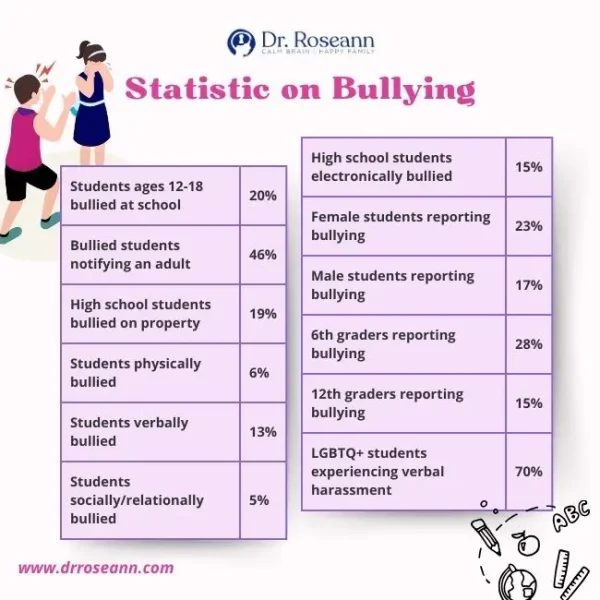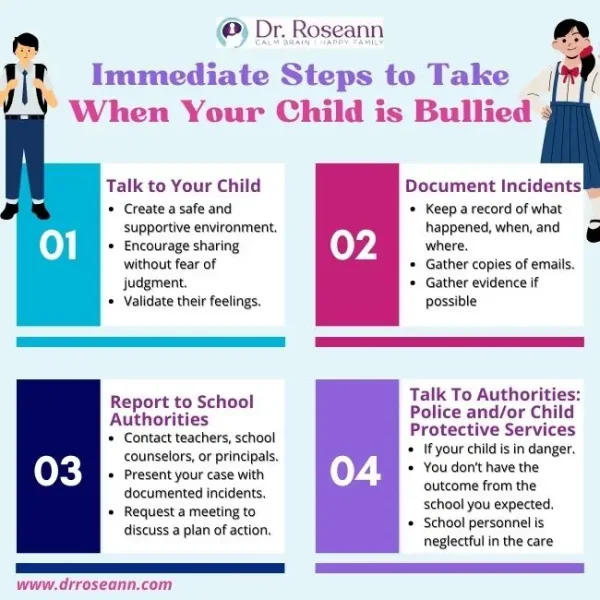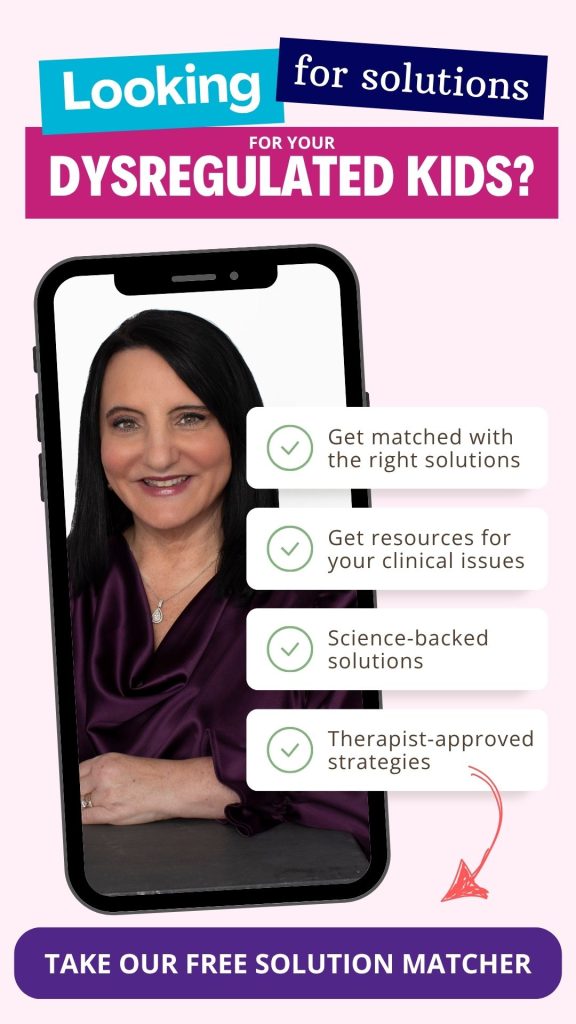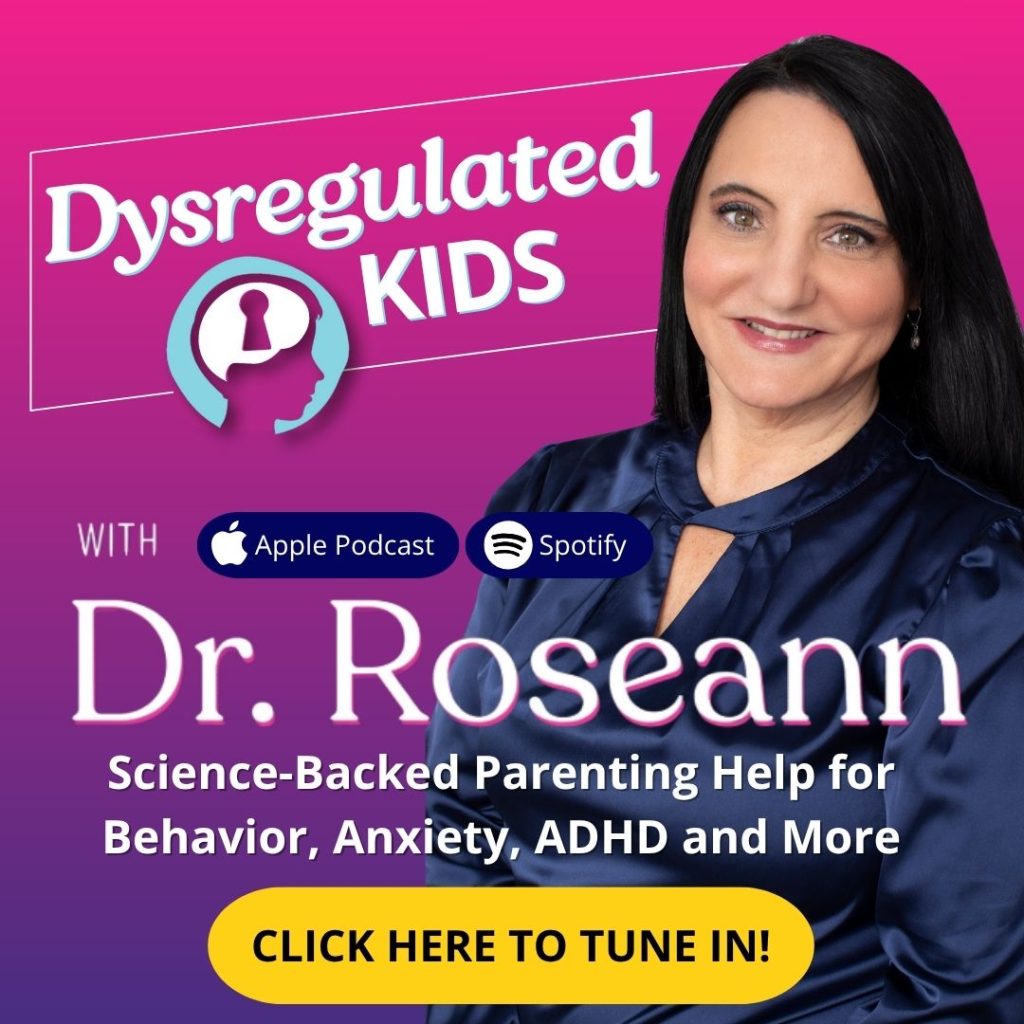Estimated reading time: 12 minutes
ADHD and bullying are a tough combo. Bullying cuts deeper for kids with ADHD as it shakes their nervous system, not just their confidence. But when we calm the brain and take clear action, we can stop the cycle and help them feel safe again.
What Is the Connection Between ADHD and Bullying?
Kids with ADHD don’t exactly fade into the background—and honestly, why should they?
But in classrooms that reward quiet compliance and neat little checkboxes, standing out can paint a target on their back.
I see it all the time in my practice. Parents walk in worn down and heartbroken: “We’ve done everything—met with teachers, rehearsed what to say—and it’s still happening.”
Last year, I worked with two students facing ongoing bullying:
- One had strong adult support and recovered well.
- The other didn’t—and the emotional toll ran much deeper.
So what’s really going on? This isn’t about bad kids or bad parenting. It’s about what happens when a dysregulated brain is expected to function in a system that doesn’t understand it.
Bottom line? What looks like behavior is really a dysregulated brain asking for support.
When we calm the brain first, everything starts to shift:
- Confidence grows
- Peer relationships improve
- Safety and healing returns
This is the real connection between ADHD and bullying. It’s not about discipline—it’s about regulation.
Why Are Kids With ADHD More Likely to Be Bullied?
Kids with ADHD are more likely to be bullied—not because they’re doing something wrong, but because their brains are wired differently.
And when those differences aren’t supported, they can stand out in ways others don’t understand. That’s the real issue.
Here are five key reasons why kids with ADHD are more vulnerable:
- Emotional dysregulation – Big reactions come fast and hard. Bullies know exactly how to push until they get one.
- Low self-esteem – After years of being told they’re “too much” or “not enough,” their confidence takes a hit.
- Social skill challenges – Missing subtle cues or tone can create confusion—and conflict.
- Impulsivity and personal space issues – They interrupt, fidget, or stand too close without even realizing it. These behaviors can wear on peers—even when there’s no harm meant.
- Frequent frustration or anger – Some kids poke on purpose just to watch them snap.
I’ve seen it over and over again—the moment real change happens is when we stop chasing surface behaviors and get to the root: a dysregulated nervous system.
That’s when the spark comes back.
That’s when confidence starts to bloom.
That’s when kids finally feel safe enough to be their true selves.
So don’t give up. This isn’t just about stopping bullying; it’s about helping your child feel calm, connected, and strong enough to thrive.
What you see as behavior is really brain dysregulation. Calm the brain first—everything else follows.
What Does Bullying Look Like?
Bullying isn’t a one-time mistake—it’s a pattern.
It’s targeted, repeated, and causes harm—emotionally, physically or socially. And for kids with ADHD, who already feel “too much” or “not enough,” it hits even harder.
What bullying can look like:
- Physical – Hitting, shoving or damaging belongings
- Verbal – Cruel jokes, name-calling or threats
- Social – Exclusion, rumors or public humiliation
- Cyberbullying – Hurtful messages through texts, games or social media
You might not catch the moment it happens. But the aftermath? That shows up loud and clear.
Signs your child might be getting bullied:
- Mysterious injuries or broken items
- Avoids school or pulls away from others
- Mood swings or restless sleep
- Drop in focus or grades
- Frequent headaches or stomachaches
Trust your gut. Kids with ADHD don’t always know how to say something’s wrong. Their pain often comes out through behavior—not words.
I’ve worked with so many children carrying invisible bruises. Some shut down. Others smile through the pain.
But no matter how they cope, dysregulation leaves a mark. What you see as behavior is really brain dysregulation.
How Common Is Bullying Among Children With ADHD?

Bullying is more than common—it’s a daily reality for many children with ADHD. Their impulsivity and social struggles often make them easy targets (Cuba Bustinza et al., 2022).
According to the National Center for Education Statistics:
- 1 in 5 students (ages 12–18) are bullied at school
- Only 46% report it to an adult
- 19% of high schoolers were bullied on school property
- 15% experienced cyberbullying
- 6% physical, 13% verbal, and 5% social/relational bullying
Some kids are more at risk:
- Girls (23%) report more bullying than boys (17%)
- Middle school sees the highest rates—28% of 6th graders
- LGBTQ+ students face the most verbal and physical harassment
And when it comes to cyberbullying, the divide gets even clearer. Girls are significantly more likely to be cybervictims, while boys report more involvement as cyberperpetrators (Heiman et al., 2014).
These numbers aren’t just statistics—they’re red flags.
Our kids—especially those with ADHD—may not say something’s wrong. But their behavior tells the story.
It’s up to us to notice the signs and give them the support they need to feel safe and regulated.
Why Do Bullies Target Kids With ADHD?
Kids with ADHD often stand out—and that can make them easy targets.
Bullies tend to zero in when:
- There’s a lack of understanding – Peers misread ADHD behaviors and react with judgment instead of compassion.
- There’s a power imbalance – Children who seem anxious, impulsive, or isolated are more likely to be picked on.
- The environment isn’t prepared – Without strong prevention programs and inclusive support, neurodivergent kids get left behind.
These aren’t just “quirks.” They’re signs of a dysregulated brain crying out for help.
And when we don’t teach others how to respond with empathy, we leave these kids wide open to harm.
What Should I Do If My Child Is Being Bullied?

If something feels off—even a whisper in your gut—listen. Bullying rarely just fizzles out on its own.
Silence? That only gives it room to grow.
1. Talk to Your Child First
Before you fire off an email or vent in a parent group, pause.
Sit down with your child and simply be with them.
- Let them speak freely.
- Remind them this isn’t their fault.
- Stay calm—your nervous system helps regulate theirs.
2. Document Everything
You don’t need to be a lawyer—just a quiet detective.
- Jot down:
- What happened
- Who was involved
- When and where it occurred
- Save all digital evidence:
- Screenshots
- Texts
- Emails or DMs (especially with cyberbullying)
- Build a paper trail, just in case you need to escalate.
- Jot down:
3. Report It to the School
Reach out with the goal of working together to protect your child.
- Contact the teacher, counselor, or principal.
- Ask for a safety plan to ensure adult supervision and intervention.
- If your child has a 504 or IEP:
- Request a meeting
- Push for added supports and protections
4. If the School Doesn’t Act
If you’re told, “We’ll keep an eye on it,” but nothing changes—don’t wait.
- Escalate to the school district
- Contact a child advocate
- Involve law enforcement if your child’s safety is at risk
When kids feel unsafe, their brain shifts into survival mode—and regulation, focus, and learning all shut down.
This isn’t about “making a fuss.” It’s about protecting your child’s nervous system—and their future.
How Can I Support My Child Emotionally Through This?
Kids with ADHD already carry more on their emotional plate than most. Add bullying, and their nervous system doesn’t just get triggered—it slams into survival mode and gets stuck there.
So how do we help them bounce back? It starts at home, with small, daily moments that send one powerful message: You are safe here.
- Validate feelings—without minimizing or fixing.
Even when their stories feel hard to hear, just being present says, “I believe you.” That’s where healing begins. - Model calm, even when they’re not.
Your nervous system is their anchor. When you stay steady, it helps their brain find its way back to calm. - Teach simple coping tools that build resilience over time.
Deep breaths. Body scans. Visualization. These aren’t one-and-done tricks—they’re brain-training tools that help your child feel more in control. - Celebrate effort, not perfection.
When they try to speak up or manage their big emotions—even if it’s messy—acknowledge it. That’s where confidence takes root. - Give them safe ways to express the hard stuff.
Art, movement, journaling… let them get it out. What their mouth can’t say, their body often will.
Because when you calm the brain, everything else can follow.
Behavior is the symptom; brain regulation is the solution.
How Should I Work With the School to Ensure My Child’s Safety?
You and the school? You’re meant to be a team. A real partnership with one goal—keeping your child safe, regulated, and ready to learn. But sometimes, you have to set the tone.
Work together by:
- Reviewing anti-bullying policies and state protections
- Setting clear expectations for follow-through
- Creating a safety plan with a go-to adult, check-ins, and exit strategies
- Updating your child’s IEP or 504 with added supports
Never hesitate to speak up. Your child deserves a safe learning environment—and a calm nervous system to thrive in it.
What If School Support Isn’t Enough?
For ADHD and bullying cases, sometimes your child needs more specialized help than the school can offer.
External supports to consider:
- Therapy to address anxiety, trauma, or emotional regulation
- ADHD coaching or social skills groups
- Parent support groups for guidance and community
- Legal support if school neglect is suspected
If your child’s symptoms are escalating—or they seem depressed or withdrawn—don’t wait. Help is out there.
How Can I Help Prevent Future Bullying?
Bullying cuts deep—like a bruise on the nervous system that doesn’t fade easily. But when you regulate the brain and take action, your child can move from surviving to thriving.
You don’t have to wait for the school system to teach your child. You can teach lifelong coping skills wherever you are.
You’re not alone—support exists.
Looking for a deeper path? Explore the Dysregulation Solution or listen to my It’s Gonna Be OK! podcast.
Start here:
- Teach self-advocacy: when to speak up, when to walk away
- Build connection through hobbies or clubs
- Work with the school on inclusion and awareness
- Use brain-based tools to support daily regulation
Regulate the brain, restore the calm—and help stop the bullying cycle.
Parent Action Steps
FAQs
Can brain-based tools really help with bullying?
Yes—when the brain is regulated, kids are better equipped to handle stress, set boundaries, and bounce back emotionally. Tools like breathwork, movement breaks, or biofeedback calm the nervous system and help kids feel more in control, which reduces the emotional toll bullying can take.
How can social-emotional learning (SEL) help prevent bullying in kids with ADHD?
SEL teaches kids how to manage emotions, read social cues, and build healthy relationships—skills that many children with ADHD struggle with. When schools implement SEL programs, they create safer, more inclusive environments where kids learn to advocate for themselves and others. That’s a big step toward preventing bullying before it starts.
What legal protections exist for kids with ADHD who are bullied?
Children with ADHD are protected under Section 504 and the Americans with Disabilities Act (ADA). Schools must take bullying seriously, especially when it impacts a child’s learning or emotional well-being. If the school fails to act, parents can request accommodations and legal support to ensure their child is safe, supported, and heard.
Are support groups helpful for families dealing with ADHD and bullying?
Absolutely. Support groups give parents and kids a safe space to share, connect, and learn from others who truly get it. You’ll gain emotional support, practical strategies, and advocacy tools that can make a real difference—because knowing you’re not alone brings strength, hope, and community.
Citations
Cuba Bustinza, C., Adams, R. E., Claussen, A. H., Vitucci, D., Danielson, M. L., Holbrook, J. R., Charania, S. N., Yamamoto, K., Nidey, N., & Froehlich, T. E. (2022). Factors Associated With Bullying Victimization and Bullying Perpetration in Children and Adolescents With ADHD: 2016 to 2017 National Survey of Children’s Health. Journal of attention disorders, 26(12), 1535–1548. https://doi.org/10.1177/10870547221085502
Heiman, T., Olenik-Shemesh, D., & Eden, S. (2014). Cyberbullying involvement among students with ADHD: relation to loneliness, self-efficacy and social support. European Journal of Special Needs Education, 30(1), 15–29. https://doi.org/10.1080/08856257.2014.943562
Dr. Roseann is a mental health expert in Neurofeedback who frequently is in the media:
- The Holistic Counseling Podcast Therapist’s Integrative Tools: Neurofeedback and Biofeedback
- Life’s Essential Ingredients Connecting at the Root
- Helping Children Thrive Podcast Benefits of Neurofeedback for children with ADHD
- She Knows 11 Products Moms of Kids With ADHD Swear By to Maintain Order in the Chaos
- The Healthy 12 Silent Signs of Adult ADHD You Might Be Ignoring
Always remember… “Calm Brain, Happy Family™”
Disclaimer: This article is not intended to give health advice and it is recommended to consult with a physician before beginning any new wellness regime. *The effectiveness of diagnosis and treatment vary by patient and condition. Dr. Roseann Capanna-Hodge, LLC does not guarantee certain results.
Are you looking for SOLUTIONS for your struggling child or teen?
Dr. Roseann and her team are all about science-backed solutions, so you are in the right place!
Grab your complimentary copy gift from Dr. Roseann











